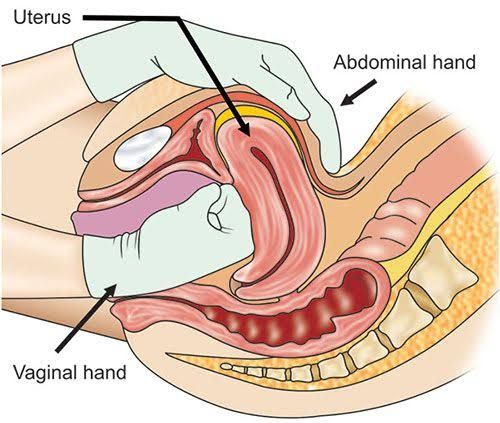
Postpartum Hemorrhage (PPH) remains a leading cause of maternal morbidity and mortality worldwide. When PPH is caused by uterine atony—the failure of the uterus to contract effectively after delivery—rapid intervention is critical. Uterine compression, specifically Bimanual Uterine Compression (BUC), is a foundational, non-surgical, life-saving maneuver that physically attempts to stem bleeding by forcing the uterine musculature to contract while simultaneously compressing large blood vessels within the uterine wall.
Preparation and Initial Management
The decision to initiate Bimanual Uterine Compression often occurs following the failure of initial pharmacological management and external massage. Time is paramount, and the response must be structured around the “Four Ts” (Tone, Trauma, Tissue, Thrombin), with atony (Tone) being the most common cause.
A. Triage and Activation
- Rapid Assessment: Confirm estimated blood loss (EBL) and rule out obvious traumatic causes (lacerations, retained placenta).
- Activate Emergency Protocol: Immediately call for assistance (anesthesia, obstetrics, nursing team) and notify the blood bank for massive transfusion protocol activation.
- Positioning and Access: Place the patient supine with legs minimally abducted. Ensure two large-bore intravenous (IV) lines (16-gauge or larger) are established.
- Monitoring: Apply continuous cardiac, blood pressure, and pulse oximetry monitoring. Insert a Foley catheter to ensure the bladder is empty, as a full bladder can inhibit effective uterine contraction.
- Initial Pharmacological Interventions (Simultaneous): Administer first-line uterotonic agents immediately, such as oxytocin, typically delivered via IV infusion, followed by backup agents such as carboprost, misoprostol, or methylergonovine (contraindicated in hypertensive patients).
B. External Fundal Massage
Before proceeding to the more invasive bimanual technique, vigorous external uterine fundal massage should be attempted to stimulate contraction.
- Technique: Place the heel of one hand just superior to the symphysis pubis to stabilize the lower uterine segment. Use the other hand to massage the uterine fundus firmly in a circular motion.
- Goal: The goal is to feel the uterus “ball up” and become firm (globular). If the uterus remains boggy and bleeding persists despite continuous massage and uterotonics within the first minute or two, Bimanual Uterine Compression must be initiated immediately.
Bimanual Uterine Compression (BUC)
Bimanual Uterine Compression is the definitive physical maneuver to mechanically compress the uterine vasculature, reducing blood flow into the uterine cavity until pharmacologic agents take effect or other specialized management (e.g., balloon tamponade, uterine artery embolization, or surgery) can be organized.
A. Indications and Precautions
- Indication: Persistent, uncontrolled PPH due to suspected uterine atony despite initial vigorous external fundal massage and administration of first-line uterotonic drugs.
- Sterility: The procedure requires an internal vaginal hand. Strict sterile technique (gloves, gown, necessary drapes) must be maintained to prevent infectious complications.
- Pain Management: This procedure is often intensely painful. Analgesia and reassurance are crucial. If the patient is unstable, rapid preparation for hemorrhage control in the operating room (OR) should continue simultaneously.
B. Procedure for Bimanual Compression
The procedure involves the coordination of one hand placed externally on the abdomen and the other hand placed internally within the vagina.
1. Preparation of the Internal Hand
- Identify Position: The operator positions themselves directly facing the patient’s perineum.
- Insertion: Under sterile conditions, the operator inserts their dominant hand (or the hand they are most comfortable with for internal manipulation) into the vagina.
- Placement: The fingers are held together in a cone shape. The hand is advanced until the knuckles reach the posterior fornix (the deep recess behind the cervix).
- Cupping the Uterus: The internal hand is then flexed into a fist or cupped against the anterior wall of the lower uterine segment, just behind the pubic bone. The goal is to push the lower uterus anteriorly and superiorly.
2. Preparation of the External Hand
- Placement: The non-dominant hand is placed externally onto the patient’s abdomen, superior to the symphysis pubis.
- Location: This hand grasps the fundus (the top of the uterus).
3. Application of Compression
The essence of the technique is to compress the uterus between the two hands, like squeezing a sponge, thereby occluding the spiral arteries and deep vessels.
- Anterior-Posterior Compression: The external hand pushes the fundus sharply downward and backward (towards the spine). Simultaneously, the internal hand elevates and pushes the lower uterine segment upward and forward (anteriorly, against the external hand).
- Sustained Force: The force applied must be firm enough to compress the uterus completely. The goal is to flatten the uterus between the two hands, effectively squeezing the blood out and promoting clotting until the natural tone returns.
- Confirmation of Efficacy: Compression is successful when the operator feels the uterus firming immediately between the hands, and the visible vaginal blood flow significantly reduces or ceases.
4. Maintenance and Monitoring During Compression
- Duration: BUC must be maintained continuously for at least 5 to 15 minutes, or until the uterus responds to pharmacological management and maintains its own tone when compression is briefly eased.
- Reassessment: While maintaining compression, the team must continuously reassess vital signs, EBL, and the effectiveness of concurrent interventions (uterotonics, fluid resuscitation, blood products).
- Release: The operator should cautiously release the compression briefly after the uterus feels firm for several minutes. If bleeding recurs, compression must be immediately reapplied.
Alternative and Adjunctive Compression Procedures
If Bimanual Uterine Compression is ineffective after 10–15 minutes, or if the patient is deteriorating rapidly, rapid escalation is required.
A. Aortic Compression (Adjunctive/Temporary)
In cases of catastrophic, unresponsive hemorrhage where immediate surgical or OR access is delayed, temporary manual compression of the abdominal aorta may reduce blood flow to the uterus, buying critical time.
- Position: The operator stands on the patient’s right side.
- Technique: The operator uses a closed fist or the heel of the hand and places it midline, superior to the umbilicus.
- Force Application: Firm, sustained pressure is applied directly downward and backward, aiming to compress the aorta against the lumbar vertebral column (L3/L4).
- Confirm Efficacy: Effectiveness is confirmed by the disappearance or significant reduction of the femoral pulse. This is a temporary measure that requires significant physical exertion and should not delay transport to the OR or application of other definitive measures.
B. Internal Uterine Balloon Tamponade (Subsequent Step)
If BUC is effective in stopping the bleeding, but immediate cessation of compression leads to recurrent bleeding, an immediate next-step intervention is often the placement of an intrauterine balloon (e.g., Bakri balloon or Sengstaken-Blakemore tube). The balloon acts as an internal compression device, mimicking the internal hand of the BUC technique, allowing stabilization while preserving fertility.
- Note: The BUC provides the critical bridge while the balloon is prepared, placed, and inflated, or while the definitive surgical team is mobilized.
Post-Procedure Management and Documentation
Once the hemorrhage is controlled, whether by BUC, balloon, or surgical intervention, meticulous post-procedure care is essential.
- Fluid and Blood Resuscitation: Continue aggressive fluid and blood product resuscitation guided by laboratory parameters (hemoglobin, coagulation profile).
- Continued Monitoring: The patient must remain in a high-acuity setting (ICU or dedicated PPH recovery area) for several hours to monitor for recurrent atony or signs of coagulopathy.
- Documentation: Detailed documentation of the entire event is mandatory, including the exact time of onset of PPH, the implementation of BUC, the duration of compression, patient vital signs, and total estimated blood loss.
- Addressing Underlying Cause: If the compression was necessary, a thorough review of the delivery and placental inspection must occur to ensure no concurrent causes (trauma, retained fragments) were missed.
Conclusion
Bimanual Uterine Compression is a fundamental, high-impact clinical skill critical for managing life-threatening PPH due to uterine atony. It demands prompt recognition of the severity of the hemorrhage and a professional, coordinated response. While compression itself is a mechanical technique, its success hinges on its integration with simultaneous pharmacological treatment, adequate resuscitation, and rapid escalation to surgical or interventional radiology options when compression techniques alone fail. Mastering this maneuver ensures the best possible outcome in one of the most urgent obstetric emergencies.
References
- American College of Obstetricians and Gynecologists (ACOG). (2020). Practice Bulletin No. 183: Postpartum Hemorrhage. Obstetrics & Gynecology, 133(4), e199–e211.
- World Health Organization (WHO). (2012). Managing complications in pregnancy and childbirth: A guide for midwives and doctors. WHO Press.
- Dahlke, J. D., B. M. D. Lapping, J. M. Show, A. E. Scifres, L. D. Hutchinson, H. L. Fields, S. L. Hackney, T. B. Haas, T. P. Burke, P. D. F. Pesch. (2015). Critical role of bimanual uterine massage in postpartum hemorrhage management: An obstetric simulation study. Simulation in Healthcare: The Journal of the Society for Simulation in Healthcare, 10(2), 107–113.
- Anderson, J. M., & Etches, D. (2007). Prevention and Management of Postpartum Hemorrhage. American Family Physician, 75(6), 875-882.
- Mousa, H. A., & Alfirevic, Z. (2014). Treatment for primary postpartum haemorrhage. Cochrane Database of Systematic Reviews, (2), CD003249.






